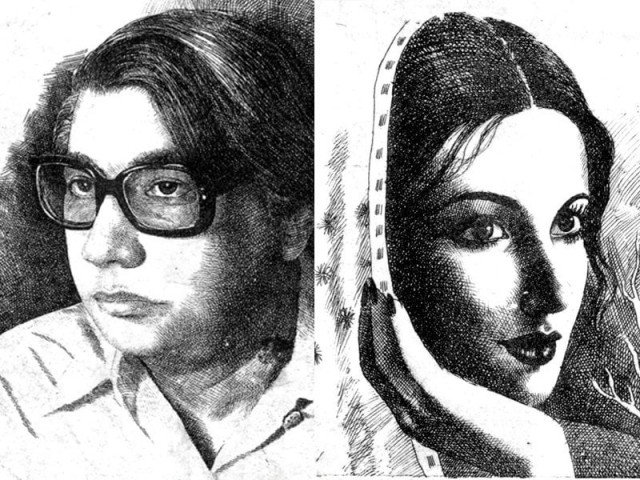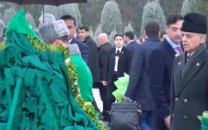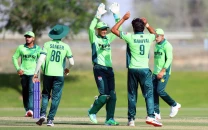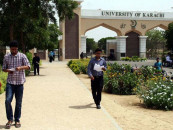Our desi valentines
Beneath growing terror, there lies a world where love of Sohni-Mahiwal, Heer-Ranjha has been celebrated for centuries.

Buried beneath the headlines of growing extremism and terror, there lies a world where the love of Sohni-Mahiwal, Heer-Ranjha and Sassi-Punho has been celebrated for centuries.
Taking advantage of the cover of darkness and the mist, a shadow appears along the outer wall of the mansion and disappears amongst the tall grass in the field. The shadow re-appears on the edge of the river Chenab across the field, revealing itself as a young woman of striking beauty. Using an earthen vessel tightly pressed against her body as a floatation device, she enters the icy cold water of the river which has swelled due to recent winter rains. Risking her life, she fights with the current to cross the river to get to Mahiwal, her lover, who is waiting anxiously for her on the other side. Something goes wrong; her vessel begins to take in water and soon dissolves in the unforgiving waves. As she begins to drown, her lover jumps in and dies trying to save her. Such was their union. “But what went wrong?” asks a bewildered voice. “Her sister-in-law had come to know of her little escapades and replaced her regular kiln-baked vessel with an unbaked [kacha] one”, croaked the raconteur. “Her who?” asks another astonished member of the audience. “She was forcibly married but never gave-in to the arrangement,” explains the old nomad narrating the story. “So what? This is beyghairti,” argues another voice. Thus continued a night of bonfire-lit story-telling on an almost empty railway platform, where only a handful of people were still optimistically waiting for a Pakistan Railway train to arrive.

It is hard to believe that Pakistan, today viewed as a breeding ground for extremism, is a land where once stories of love and romance were not only omnipresent but also celebrated and cherished by the masses. No, we are not talking about Nadeem and Shabnam’s motorcycle acrobatics on the deserted Clifton roads of the 1970s. Nor are we discussing Waheed Murad swaying by a tree as Zeba looks on shyly. Romance has featured in the folklore and literature of the Indo-Pak subcontinent, Persia and Afghanistan for millennia. Incredible as it sounds, the sufis who graced this land immortalised many a famous romantic stories in their poetry — the same poetry which is said to have played a pivotal role in the spread of Islam in this region. One such sufi poet was Shah Abdul Lateef Bhittai. The very-much-married-to-another-man and very-much-still-in-love-with-Mahiwal, Sohni, happens to be one of the seven heroines of Shah Abdul Latif Bhittai who feature in Shah jo Risalo. It is strange to think that, in the land of Shah Saein, today, Sohni would probably have been declared a Kari and buried unceremoniously in the infamous graveyard of the Karis.
Heer too was married off to another man while her beloved Ranjha became a “Jogie”. She refused her marriage and then was set free. Today, Sohni Mahiwal, Heer Ranjha and others like them would probably have to face the Hudood Ordinance or perhaps would have been stoned to death.

But both Heer and Sohni were lucky that they lived in another time when love was generally accepted as a divine gift. It was a time when people thought that it is only the chosen few who tread the path of love and they have to pay a heavy price for it.
“Khali dil naiyo, Jaan wi aye mangda
Ishqay di gali ich koi koi langda”.
(Not only the heart, but it asks for life as a toll too
It is only a few who can tread the road of love)
Sohni-Mahiwal, Heer-Ranjha, and many other romantic couples from our folk stories, are all hailed as heroes and heroines. In some cases, they were even revered as saints. Sassi from Bhambore, and Punhu, a visiting prince of Makran, fell in love and decided to marry. Their marriage never got approval from Punho’s brothers who, helped by Sassi’s jealous friend, kidnapped Punho. He broke free while being forcibly taken back to Makran. Meanwhile Sassi left Bhambore in search of him. After many hardships, the two lovers met in the Lasbela district of Balochistan. Mother earth is said to have provided them refuge by splitting up and enclosing them in a single grave, which to this day is visited and revered by thousands. In the collective conscience of our society, the verdict on characters such as Punho’s brothers, Sassi’s jealous friend, Heer’s uncle Kaidu, who was the main cause of tragedy in that lore is very clear. They were all labeled as villains and their names are sometimes used today to express contempt.

One such villain from the folklore of Shireen Farhad has a tomb dedicated to her near the single grave of Shireen Farhad at Lak Jao in Balochistan, but a particular ritual is performed at her grave regularly by devoted visitors — they throw stones at her grave in contempt! This then, summarises the reaction of the masses, towards such uninvited intrusions in romances.
In recent years, the advent of February creates an interesting situation across Pakistan’s urban centers and increasingly, even rural areas. The society gets polarised around whether to celebrate Valentine’s Day or not. Die-hard Romeos and Juliets believe that the day is meant for the expression of their “eternal” love for a special someone. On the other hand, there are those who believe that having anything to do with the festivities will guarantee a one way ticket to hell.
Both the Cupid-struck and the V-day haters ignore some aspects. Whether invented in the non-Muslim West or Timbuktu, Valentine’s Day is an occasion to express the universal emotion of love. Its universality not only refers to space but time as well — why confine love to a single day? Why not honour our loved ones every single day of our lives? Secondly, love, even the romantic variety, is not a copy-righted invention of the West. Heer-Ranjha, Laila-Majnu, Sohni-Mahiwal, Sassi-Punho, Hani-Shehmurid, Mirza-Sahiban, Yousuf Khan-Sheherbano were all romances that had taken place before Valentines was even heard of in this part of the world!
Room for romances and love stories has certainly shrunk over time and they have come to be accepted as a foreign influence both by conservatives and liberals. Even the Middle Eastern romances of Aladdin and the adventures of Sindbad gain legitimacy only when dished out by Disney and Dreamworks. Interestingly, people know so little about indigenous love stories and romances that they often believe that Omar and Marvi were lovers. Whereas, the fact is that Omar, the ruler of a state in Sindh, fell for the beautiful Marvi and upon her refusal, had her kidnapped and locked up in his palace! To Omar’s credit, he did not force himself upon her beyond this, hoping that Marvi would give in. Marvi remained defiant, and the impressed Omar set her free — with no love lost between the two.
Amusingly, in today’s age of fundamentalism co-existing not-so-peacefully with liberal ideas, the Baloch love story of Hani-Shehmureed would probably not invoke the Hudood Ordinance but would certainly invite the ire of women’s liberation folk and feminists. Shehmureed had been tricked into giving away Hani, then his fiancée, as a reward to a group of musicians. Respecting the prevailing customs, the honorable Shehmureed lived up to his word and backed off from Hani, while she accepted the arrangement to keep his honour. Such selfless “love” is incomprehensible today. On the other hand, in Yusuf Khan — Sherbano folklore from the Khyber Pakhtunkhwa, Sherbano was close to receiving the ire of her father and brothers after she attended to the injured Yusuf Khan by placing his head in her lap. Yet the menfolk of her family were sensible enough to calm down and accede when Yusuf Khan’s mother declared to send a proposal following proper protocol. This is a surprising display of understanding and restraint by the menfolk of tribal areas.
Meanwhile, far from these debates, at Sohni’s shrine in Shahdadpur, Sindh, a faqir sings…
Mainu Paar Laga dey way .. gharya mintan teriyan kardi
Huwa wail naseebon say gharya yaar na mera chootay
O! earthen float, help me across, I beg thee
O! earthen float, I fear losing my hard earned love
Here, Sohni is revered as “Maa Sohni” by some. This is how the masses own romance and love throughout Pakistan. From the rugged hills of the Hindukush through the Indus plains right down to the sands of Makran and the coastal ruins of Bhambore, lovers have been hailed as heroes and heroines of this land. Here, indigenous versions of concerts are performed complete with music and dance; songs of Heer and Sur Sohni ring out loud at the urs of these characters, which are usually public fairs. Can we call these celebrations our versions of Valentine’s Day?
Published in The Express Tribune, Sunday Magazine, February 10th, 2013.
Like Express Tribune Magazine on Facebook to stay informed and join the conversation.



















COMMENTS
Comments are moderated and generally will be posted if they are on-topic and not abusive.
For more information, please see our Comments FAQ